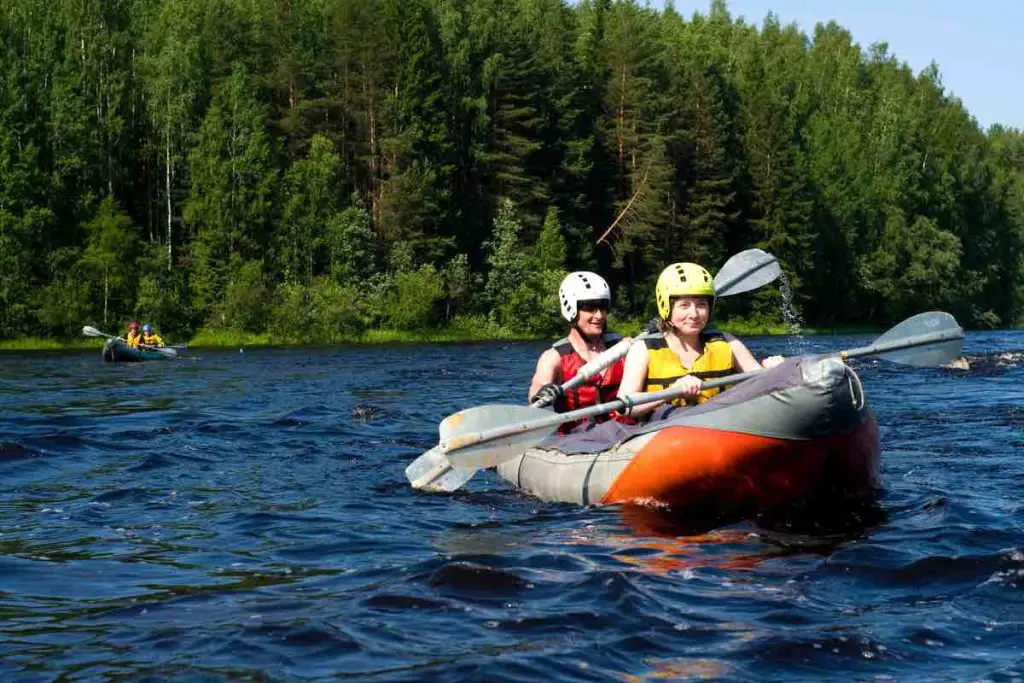You’re out kayaking and suddenly find yourself going in circles, despite your best efforts to paddle straight. It’s frustrating and even dangerous if you’re in a tight space or near rocks. Here is why your kayak goes in circles.
There are many reasons your kayak goes in circles. It could be that your kayak is unbalanced and needs more weight in the front, or the tide could be more potent than you realize and be pulling you out to sea. More likely, you’re simply experiencing a phenomenon known as the Coriolis effect.
Here are 11 of the most likely reasons why your kayak might start going in circles – and what you can do to stop it from happening.

1. You’re Paddling on the Wrong Side
It’s easy to forget which side of the kayak you’re supposed to be paddling on especially if you’re not used to kayaking or the boat is moving around a lot. Getting your strokes in the wrong direction can quickly send you spinning in circles.
Here are a few tips for remembering which side is which:
- If facing the front of the kayak, you should paddle on the right.
- If you’re facing the back of the kayak, paddle on the left side.
- Look where the other people in your group are paddling – and do what they’re doing!
2. You’re Not Paddling Hard Enough
Some kayakers might not paddle hard enough when starting. After all, moving a kayak through the water takes a lot of energy, and it’s tempting to take it easy to save your strength.
However, if you want to stay on course – especially in a tight space or near rocks – you must paddle with all your might. Make sure you’re using strong, even strokes and that your paddle is entering the water perpendicularly.
3. You’re Paddling Too Hard
We’ve all been there before – you’re paddling as hard as you can, but your kayak just won’t go in a straight line. If this sounds familiar, you’re likely making one of these typical mistakes. First, make sure you’re using strong, even strokes. You should also exit the water at a perpendicular angle to avoid veering off course.
Second, if your paddle is too long, it will be more challenging to control. If you’re struggling to steer, try using a shorter one for better maneuverability. A longer paddle gives you more leverage, but it’s not always worth the trade-off.
4. You’re Paddling Too Slowly
Paddling too slowly can also cause your kayak to veer off course. This is because when you paddle slowly, your kayak will drift sideways due to the current. To keep paddling straight, you must maintain a consistent speed and keep your kayak moving forward.
Paddling in a straight line can be tricky, but by avoiding these common mistakes, you’ll be able to stay on course and enjoy a peaceful day out on the water.
5. You’re Not Centered in Your Kayak
To paddle in a straight line, ensure your weight is evenly distributed and you’re sitting up straight. If you’re not centered in your kayak, it will naturally start to tilt to one side or the other. This will cause it to veer off course.
If you are constantly veering to one side, try adjusting your position until you’re more centered. By keeping yourself centered, you’ll be able to paddle straighter and stay on course. You may also need to redistribute your weight if you carry any gear.
6. You’re Not Looking Where You Want To Go
When you’re out on the open water in your kayak, it’s easy to get distracted by the scenery. But if you’re not careful, you can quickly find yourself off course.
The key to paddling in a straight line is to keep your eyes focused on the horizon. Resist the temptation to look around, and your kayak will follow your gaze.
7. You’ve Got Poor Stroke Technique
Anyone who has tried to kayak knows it is not as easy as it looks. A big part of the problem is poor stroke technique. Paddling in a straight line is notoriously tricky, and even the slightest deviation can send you veering off course.
The next time you’re out on the water, pay close attention to your stroke technique and see if you can make some improvements. Keeping the kayak on track will be challenging if your strokes are weak or uneven. In addition, your paddle needs to enter the water at a perpendicular angle to provide the most thrust.
8. There’s Wind Blowing Against You
Wind can be a pain when paddling in a straight line. The wind will push your kayak off course, making it harder to progress. If you find yourself paddling into the wind, you can do a few things to make it easier.
First, make sure you’re using strong, even strokes. You want your paddle to enter the water perpendicularly, so put some muscle into it.
Additionally, try paddling on both sides of your kayak equally. This will help keep it balanced and prevent it from veering off course.
9. You’re Not Digging Deep Enough Into the Water
With each stroke, your kayak will veer off course if you’re not digging deep enough into the water. This is because a shallower stroke won’t generate as much force, making it harder to move forward in a straight line. To paddle more efficiently, you need to make sure that each stroke digs deep into the water so that you can generate maximum force.
10. You’ve Got an Asymmetrical Paddle
If your paddle is asymmetrical, it will be harder to paddle in a straight line. This is because an asymmetrical paddle creates an uneven force, which can cause your kayak to veer off course. When shopping for a new paddle, choose one that is symmetrical. This will help you paddle more efficiently and keep your kayak on track.
11. You Are Experiencing the Coriolis Effect
The Coriolis effect results from the earth’s rotation and can cause objects to veer off course. This is most commonly experienced when shooting long-range artillery but can also affect kayaks. The best way to counteract the Coriolis effect is by paddling on both sides of your kayak equally; this will help keep it balanced and prevent it from veering off course.
It’s not difficult to find affordable kayak paddles. However, high-quality ones tend to be expensive. Read my guide to learn more about the reason. [XX Reasons Why Kayak Paddles Are So Expensive]

Sources
- Coastal Angler Mag: SUP Report August 2018: You’re Paddling With The Wrong Side Of The Paddle…
- Rei Co op: How to Paddle a Kayak: Basic Strokes
- Kayak Help: 7 Kayaking strokes to improve your kayaking
- Paddling Magazine: The industry has been sizing kayak paddles wrong for years
- Kayak Help: Average Kayak Speed
- Kayak Sailor: Load Balance and Directional Stability
- Paddling magazine: 5 Strokes that will help you improve your paddling
- Paddling magazine: Make safe passage with these tips for canoeing in the wind
- Foreign Policy: Stuff I didn’t know: Earth’s rotation affects the accuracy of long-range shells
- Project Atmosphere: Coriolis Effect Because the earth turns:
